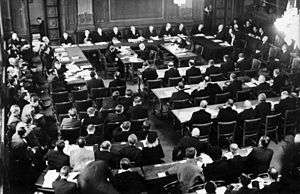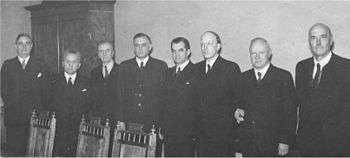War-responsibility trials in Finland
The war-responsibility trials in Finland (Finnish: Sotasyyllisyysoikeudenkäynti, Swedish: Krigsansvarighetsprocessen) were trials of the Finnish wartime leaders held responsible for "definitely influencing Finland in getting into a war with the Soviet Union and United Kingdom in 1941 or preventing peace" during the Continuation War, the Finnish term for their participation in the Second World War from 1941–1944. Unlike other World War II war-responsibility trials, the Finnish trials were not international. The trials were conducted from November 1945 through February 1946 by a special court consisting of the presidents of the Supreme Court of Finland, the Supreme Administrative Court of Finland, a professor from the University of Helsinki and twelve MPs appointed by the Parliament of Finland.

Background
The Moscow Armistice, signed September 19, 1944, contained the following Article 13:
Finland undertakes to collaborate with the Allied powers in the apprehension of persons accused of war crimes and in their trial.[1]
The Finns initially thought that the trials would be for conventional war crimes. However, as the Moscow Declaration of October 30, 1943 made clear, the Allied powers intended to prosecute for other actions as well.
The Allied Control Commission and the Communist Party of Finland raised the issue of the trials repeatedly during the spring and summer of 1945. When the Treaty of London (London Charter) August 8, 1945 defined three types of crimes, war crimes, crimes against peace and crimes against humanity, it became evident that Finland couldn't be the only country fighting on the German side where leaders wouldn't be convicted. On September 11, the parliament passed a law enabling prosecution of those responsible for war. The Supreme Court of Finland and leading judicial experts protested the law as conflicting with the constitution of Finland and contrary to Western judicial principles (it was designed to apply retroactively), but they didn't comment on the political necessity of it. The Finnish public regarded it as a mockery of the rule of law. Juho Kusti Paasikivi, who was the prime minister of Finland at the time, is known to have stated that the conditions of the armistice concerning this matter disregarded all laws.
The trial
The trials were conducted in Finland under Finnish (retroactive) law with Finnish judges. The law limited criminal liability to the highest leadership; only politicians and the Finnish war-time ambassador in Berlin, Toivo Mikael Kivimäki, were prosecuted.
The consolidated trial started on November 15, 1945. The Allied Control Commission, which monitored the implementation of the armistice on behalf of the Allies, set up a committee to observe the trials and interfered on numerous occasions before the trials ended in February 1946.
The accused

| Accused | Status | Punishment |
|---|---|---|
| Risto Ryti | 5th President of Finland | 10 years in prison |
| Jukka Rangell | 25th prime minister of Finland | 6 years in prison |
| Edwin Linkomies | 28th prime minister of Finland | 5 years and 6 months in prison |
| Väinö Tanner | cabinet minister | 5 years and 6 months in prison |
| Toivo Kivimäki | Finland's ambassador to Nazi Germany | 5 years in prison |
| Henrik Ramsay | cabinet minister | 2 years and 6 months in prison |
| Antti Kukkonen | cabinet minister | 2 years in prison |
| Tyko Reinikka | cabinet minister | 2 years in prison |
On the negotiations between the leadership of the Communist Party of Finland and Andrei Zhdanov, the chairman of Allied Control Commission the question of removal of Väinö Tanner, the chairman of the Social Democratic Party, was raised. In his private notes Zhdanov wrote: "If Tanner is removed, the Social Democratic Party will shatter..." thus opening the road to Communist control of the left.
Reactions to the trial
Most Finns viewed the War Responsibility Trials as a kangaroo court set up by the Soviet Union in order to discredit the Finnish wartime leaders,[2] since ex post facto law was against the Finnish Constitution.
Even worse in the public opinion was the fact that the Soviet leadership, which had conducted a war of aggression, the Winter War, just 19 months before Finland started the Continuation War by attacking the Soviet Union, were not indicted at all, making the whole process hypocritical victor's justice in their view.[3][4] The conviction of Väinö Tanner did not shatter the Social Democrats as Zhdanov had predicted; on the contrary, it made him a martyr and hardened the anti-communist stance in the party. Communist sympathizers were ousted from the Social Democrats and control of the labor unions was bitterly contested.
Even President Paasikivi complained to his aide that the convictions handed down in the Trials were one of the biggest stumbling blocks to improving relations between Finland and the Soviet Union.
Aftermath
After the Paris Peace treaty was ratified in the Soviet Union August 29, 1947, the Allied Control Commission left Finland on September 26, 1947. President Paasikivi paroled Kukkonen and Reinikka in October and Ramsay in December when they had served five-sixths of their sentences. The rest were granted parole in accordance with Finnish criminal law when they had served half of their sentences. On May 19, 1949 Paasikivi pardoned Ryti, who was hospitalized (his health collapsed during the imprisonment and he remained an invalid until his death in 1956). He also pardoned Rangell, Tanner, Linkomies, and Kivimäki, who were still on parole. That day, Paasikivi wrote in his diary: "[It was] ... the most noble deed, I have participated in, in the last five years."
Footnotes
- Armistice Agreement between the Union of Soviet Socialist Republics and the United Kingdom of Great Britain and Northern Ireland, on the one hand, and Finland on the other
- Pentti Virrankoski: Suomen Historia 2, p.938
- Pentti Virrankoski: Suomen Historia 2, pp. 938–9
- Juho Kusti Paasikivi: Päiväkirjat 1944–1956
References
- Jakobson, Max (former Finnish Ambassador to the UN); Finnish wartime leaders on trial for "war guilt" 60 years ago Helsingin Sanomat International edition, 28 October 2005
- Meinander, Henrik: Finlands Historia. Part 4 pp. 279–282, ISBN 9515008832
- Rautkallio, Hannu: Sotasyyllisyysnäytelmä, ISBN 951-35-2520-1, Savonlinnan Kirjapaino Oy, 1981
- Rosendahl, Anja & Saija, Olavi: Ajasta Aikaan – Suomen historian käännekohtia (Turning points in Finland's history), WSOY 1995
- Turtola, Martti: Risto Ryti: Elämä isänmaan puolesta, ISBN 951-1-11783-1, Otava, 1994
Further reading
- Lehtinen, Lasse; and Rautkallio, Hannu; Kansakunnan sijaiskärsijät ("Scapegoats of the Nation"[1]), WSOY 2005
- Tarkka, Jukka; Nobody wanted a cell near Edwin Linkomies Helsingin Sanomat International edition, 28 October 2005
- Wuorinen, John H. (1948), ed., Finland and World War II, 1939-1944, New York: Roland Press.
- Jakobson References